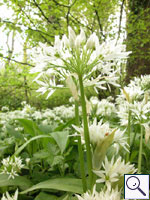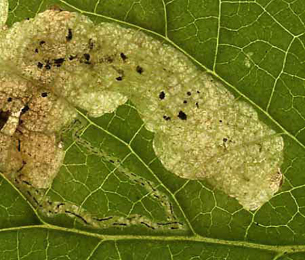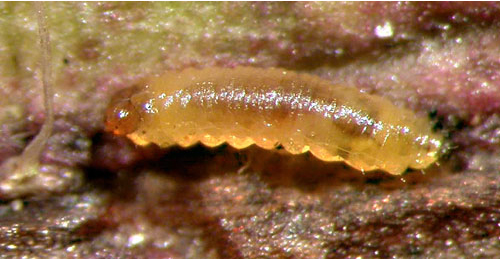 |
| |
(Coleoptera, Diptera, Hymenoptera and Lepidoptera)
by
Brian Pitkin, Willem Ellis, Colin Plant and Rob Edmunds
|
|
|
|
ALLIUM.
Chives, leeks, onions, garlics, ramsons. [Amaryllidaceae]
|
|
More than twenty
species of Allium are recorded in Britain, including the
native species Ramsons (A. ursinum L.), Wild Onion (A.
vineale L.), Chives (A. schoenoprasum L.), Sand Leek
(A. scorodoprasum L.), Round-headed Leek (A. sphaerocephalon
L.) and Field Garlic (A. oleraceum L.).
Round-headed
Leek is protected under Schedule 8 of the Wildlife and Countryside
Act, 1981.
Seven British miners are recorded on Allium.
A key to the European miners recorded on Allium is provided in Bladmineerders van Europa. |

Ramsons
Allium ursinum
|
Key for the identification of the known mines of British
Diptera recorded on Allium
|
| |
Note: Diptera larvae may live in a corridor mine, a corridor-blotch mine, or a blotch mine, but never in a case, a rolled or folded leaf, a tentiform mine or sandwiched between two more or less circular leaf sections in later instars. Pupation never in a cocoon. All mining Diptera larvae are leg-less maggots without a head capsule (see examples). They never have thoracic or abdominal legs. They do not have chewing mouthparts, although they do have a characteristic cephalo-pharyngeal skeleton (see examples), usually visible internally through the body wall. The larvae lie on their sides within the mine and use their pick-like mouthparts to feed on plant tissue. In some corridor miners frass may lie in two rows on alternate sides of the mine. In order to vacate the mine the fully grown larva cuts an exit slit, which is usually semi-circular (see Liriomyza huidobrensis video). The pupa is formed within the hardened last larval skin or puparium and as a result sheaths enclosing head appendages, wings and legs are not visible externally (see examples).
See Key to non-Diptera.
|
1a > Leaf-miner: Mine linear, whitish, both upper and lower surface. Pupation internal,
at the end of the mine with the anterior spiracles projecting through
the epidermis (Spencer, 1976:
433).
Upper-surface,
less often lower-surface corridor. Frass in isolated grains. Pupation
within the mine, usually in a lower-surface puparial chamber.
A long whitish upper surface corridor, which eventually goes lower surface. |
|
|
Two
highly polyphagous species of Chromatomyia, with indistinguishable
mines, have been recorded in Britain. These are syngenesiae (Hardy) and horticola (Goureau) which can only be distinguished by the male genitalia. Both species are widespread in Britain and elsewhere, although syngenesiae is almost entirely restricted to Asteraceae. Records on Asteraceae not based on examination of male genitalia are treated in this account as Chromatomyia 'atricornis'.
Chromatomyia horticola is recorded on 160 plant genera in 31 families of which 55 plant
genera in 19 families, including Allium, in Britain.
|
Chromatomyia
horticola (Goureau, 1851) [Diptera: Agromyzidae]. |
1b > Leaf-miner: Irregular
mine, locally shallow, elsewhere much deeper, giving it a mottled
appearance. In broadleaved plants the mine often begins as a blotch
with stellate extensions, but sometimes as a very fine, shallow
corridor. In grasses the mine often begins in the leaf sheath. The
frass is very fine-grained, initially scattered, later in aggregates.
The egg is deposited on the plant surface, and the empty egg shell
remains visible. But the larvae are able to leave their mine and
restart elsewhere, thus mines without an egg shell can be found
as well. The larva also leaves the mine before pupation. Pupation
takes place in a newly made, small, blotch mine without frass; this
mine may be made in another plant (species). |

Mine
of Amauromyza lamii on Stachys sylvatica
Image: © Willem Ellis (Bladmineerders van Europa) |
|
Polyphagpus. On
? Alisma, ? Damasonium,
? Sagittaria, ? Bellis,
? Rorippa, Tropaeolum, ? Lychnis,
? Stellaria,
? Carex,
? Cyperus,
? Scirpus,
? Hydrocharis,
? Stratiotes,
? Lamium,
? Lemna,
? Allium, Arrhenatherum,
? Polygonum,
? Potamogeton,
? Veronica,
? Typha in Britain.
On ? Alisma,
? Damasonium, ? Sagittaria,
? Bellis, ? Rorippa, Tropaeolum, Lychnis,
? Stellaria, Carex,
? Scirpus, Trifolium,
? Hydrocharis, Lamium,
? Lemna, Allium, Papaver, Agrostis, Alopecurus, Apera, Arrhenatherum, Avena, Avenula, Brachypodium, Briza, Bromus, Calamagrostis, Dactylis, Desmazeria, Digitaria, Echinochloa, Eleusine, Elymus, Festuca, Gaudinia, Glyceria, Holcus, Hordeum, Lagurus, Lolium, Panicum, Phalaris, Phleum, Phragmites, Poa, Secale, Setaria, Triticum,
? Polygonum, ? Potamogeton, Veronica, ? Typha and Verbena elsewhere.
Widespread in England. Also recorded in the Republic of Ireland.
Widespread in the Palaearctic region. Also recorded from Nearctic
and Australasian Regions.
|
Hydrellia
griseola (Fallén, 1813) [Diptera: Ephydridae]. |
1c > Leaf-miner: Corridor-blotch mine. Mine either upper or underside,
whitish. Frass in small black clumps. |
On Allium in Britain (record ambiguous). On Allium elsewhere. Widespread, from the Orkney Islands in the north to
the Channel Islands in the south in Britain. Widespread in continental
Europe. Also recorded from the Afro-tropical region, Australian
region, East Palaearctic, Near East, Nearctic region, Neotropical
region, North Africa and North Africa.
|
Scaptomyza
pallida (Zetterstedt, 1847) [Diptera: Drosophilidae]. |
1d > Leaf-miner: A distinctive mine primarily above mid-rib, with irregular short
lateral offshoots into leaf blade. Pupation external (Spencer, 1972:
51 (fig. 172), 55; Spencer, 1976:
270, 271 (fig. 486)).
Branched,
whitish, upper-surface corridor; main axis overlying the midrib;
side branches overlying the main lateral veins. (In Campanula and Phyteuma the mine is much less branched, sometimes nothing
more than a corridor on top of the midrib). Frass in rather long
strings. Usually the mines begins as a long and narrow, shallow,
tortuous lower-surface corridor that ends upon the midrib but otherwise
is not associated with the leaf venation. Often this initial corridor
is filled with callus, and then even less conspicuous. Pupation
outside the mine.
A
linear mine on the upper surface, usually following the midrib and
showing side branches along the veins. The frass is in strings. |
|

Liriomyza strigata larva, lateral
Image: © Willem Ellis (Bladmineerders van Europa)
|
Polyphagous. On more than 40 host genera in 15 families, but not yet on Allium,
in Britain and elsewhere. Widespread throughout Britain. Also
recorded in the Republic of Ireland. Widespread in continental
Europe.
|
Liriomyza
strigata (Meigen, 1830) [Diptera: Agromyzidae]. |
1e > Leaf-miner: Oviposition
in a leaf axil; from there a corridor descends along the leaf inner
side. Part of the length of the corridor is below the surface. Often
several mines per plant. Most of the feeding punctures are arranged
in lines, parallel to the leaf. Pupation takes place low in the
the plant, near the leaf base. The brown pupariria are situated within
the mine. They can best be found by bending the outer leaves outwards,
and inspecting their bases (Collins and Lole, 2005). |
On Allium in Britain and elsewhere. West Midlands. Widespread in continental Europe
|
Phytomyza
gymnostoma Loew, 1858 [Diptera:
Agromyzidae]. |
Key for the identification of the known mines of British
non-Diptera recorded on
Allium
|
Note: The larvae of mining Coleoptera, Hymenoptera and Lepidoptera may live in a corridor mine, a corridor-blotch mine, a blotch mine, a case, a rolled or folded leaf, a tentiform mine or sandwiched between two more or less circular leaf sections in later instars. Larva may pupate in a silk cocoon. The larva may have six legs (although they may be reduced or absent), a head capsule and chewing mouthparts with opposable mandibles (see video of a gracillarid larva feeding). Larvae of Hymenoptera and Lepidoptera usually also have abdominal legs (see examples). Frass, if present, never in two rows. Unless feeding externally from within a case the larva usually vacates the mine by chewing an exit hole. Pupa with visible head appendages, wings and legs which lie in sheaths (see examples).
|
1a >
Leaf-miner / stem-borer: Very variable mine - corridor or blotch,
with or without frass. The
larvae mine the leaves at first. In leeks it then bores through
them and later enters the middle to feed on the inner leaves. In
onion it feeds inside the leaves and can enter the bulb to feed. The larva pupates in an open network cocoon, either on the foodplant or close by. |
|
|
On Allium spp. in Britain and elsewhere. Although it has
the potential to be a pest, it is rather scarce and local. It
is distributed mainly in the south-east of England, especially
around the coast. Widespread in continental Europe.
|
Acrolepiopsis
assectella (Zeller, 1839) [Lepidoptera:
Acrolepiidae]. |
1b > Leaf-miner: The
mine begins in the midrib, especially in a lower leaf, extending
into the leaf disc, branching irregularly or pinnately, may also
locally be blotch like. The mine is brown and very transparent.
Sides very irregularly eaten out. Frass loosely dispersed or in
a loose central line, buy may also be pressed against the sides
of the corridor. The larva may also leave the mine and restart elsewhere. |
|

Orthochaetes
setiger larva, dorsal
Image: © Jean-Yves Baugnée (Bladmineerders van Europa) |
Polyphagous. On numerous genera and species in several plant families, including Allium, in Britain and elsewhere. Widespread in England
and continental Europe. Also recorded in the Republic of Ireland.
|
Orthochaetes
setiger (Beck, 1817) [Coleoptera:
Curculionidae]. |
|
|




